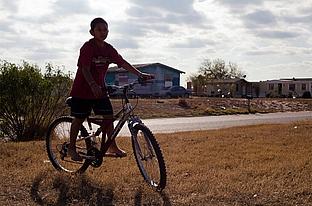Colonias: Third World Health Conditions, Deep in the Heart of Texas

Journalist Emily Ramshaw never expected to see diseases like dengue fever, dysentery and even leprosy in Texas' colonias, the impoverished neighborhoods where thousands of Latino families have lived for decades without access to running water, electricity or sanitation.
Her recent series on colonias, published in the Texas Tribune and New York Times, documented these third-world health conditions and more in damning detail, taking Texas officials to task for not doing more to improve these communities. Ramshaw produced the series as a National Health Journalism Fellow.
Here is a short excerpt from one of the series' stories:
Along the 1,248-mile Texas-Mexico border from El Paso to Brownsville, in communities with names like Agua Dulce and Mexico Chiquito, the overwhelmingly Hispanic residents of these colonias tell identical stories: of migrating with dreams of safety and prosperity, of getting swindled or misled into buying worthless land with no modern infrastructure, of sticking it out so their children - most of them American citizens - will get educated. And of getting sick.
At last count, nearly 45,000 people lived in the 350 Texas colonias classified by the state as at the "highest health risk," meaning residents of these often unincorporated subdivisions have no running water, no wastewater treatment, no paved roads or solid waste disposal. Water- and mosquito-borne illnesses are rampant, the result of poor drainage, pooling sewage and water contaminated by leaking septic tanks. Burning garbage, cockroaches, vermin and mold lead to high rates of asthma, rashes and lice infestations. And the poor diet so intrinsically linked to poverty contributes to dental problems, diabetes and other chronic conditions, which residents of the colonias rarely have the health insurance, money or access to regular health care to treat.
"People have written about conditions in the colonias for years, but when you write about kids getting leprosy and dysentery that really shakes people up," she told National Health Journalism Fellows gathered in Los Angeles last week for a seminar. "Texas would like to ignore them. Colonias have been in place for more than 50 years. I wanted to be able to really point the finger – why after all these years and all this attention are (colonias) still here and in bad shape?"
Ramshaw, an investigative reporter and assistant managing editor for the Texas Tribune, battled residents' fear and bureaucratic complacency to report her series. Here, distilled from her talk, are some take-home lessons for journalists reporting on health and social conditions in marginalized communities.
1. Find a guide. When Ramshaw, who is white but speaks Spanish, entered the colonias on her own, people would run away from her, thinking she was from immigration. Eventually, she came to know colonia residents by working with community organizers and promotoras.
2. Sometimes bureaucratic stonewalling doesn't hurt your story. It is the story. "Colonias are in unincorporated areas and don't fall under anybody's watchful eye, allowing cities and counties to say ‘not my problem,'" Ramshaw said. There is a state colonias director, who basically told Ramshaw her agency had no regulatory or enforcement authority. As bureaucrats repeatedly fed her jargon about "coordination" and "stakeholders," Ramshaw realized "that was the story – the inability to have any legitimate discourse about the situation is the problem. It was really time for someone to take a look at why these colonias directors weren't getting anything done."
3. Be realistic about your story's impact. While the president of a local university offered two teens highlighted in one story a free ride to college, prospects for more significant change at the state level remain bleak. Texas state officials are slashing many social and development programs amid a budget shortfall. Still, Ramshaw wryly noted, $6 billion remains in the state's rainy day fund.

